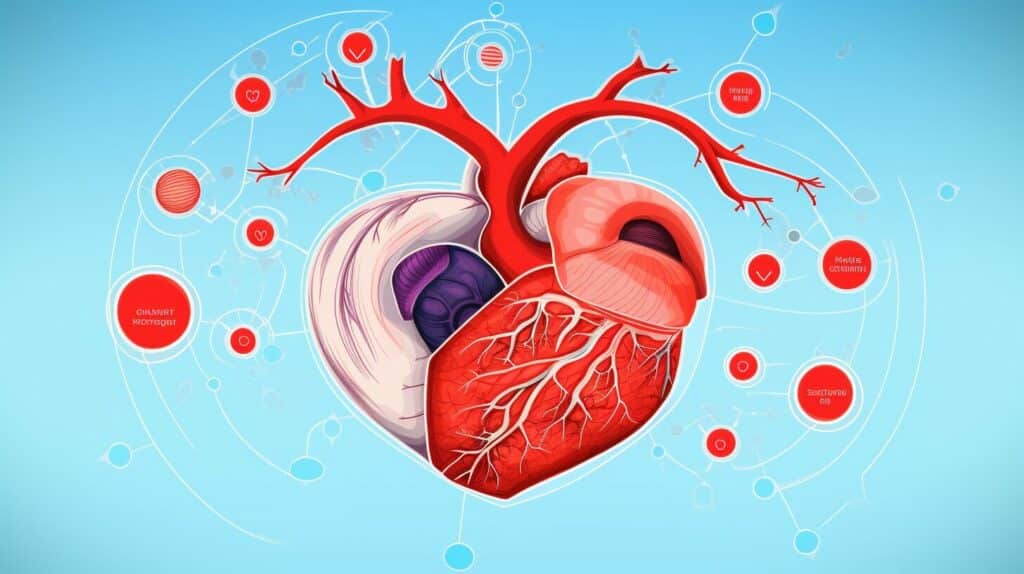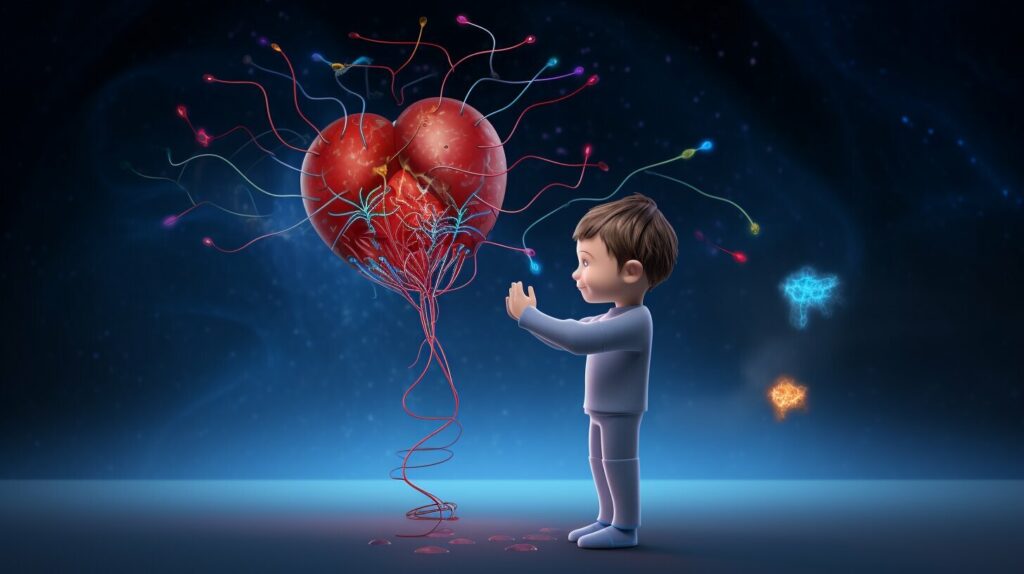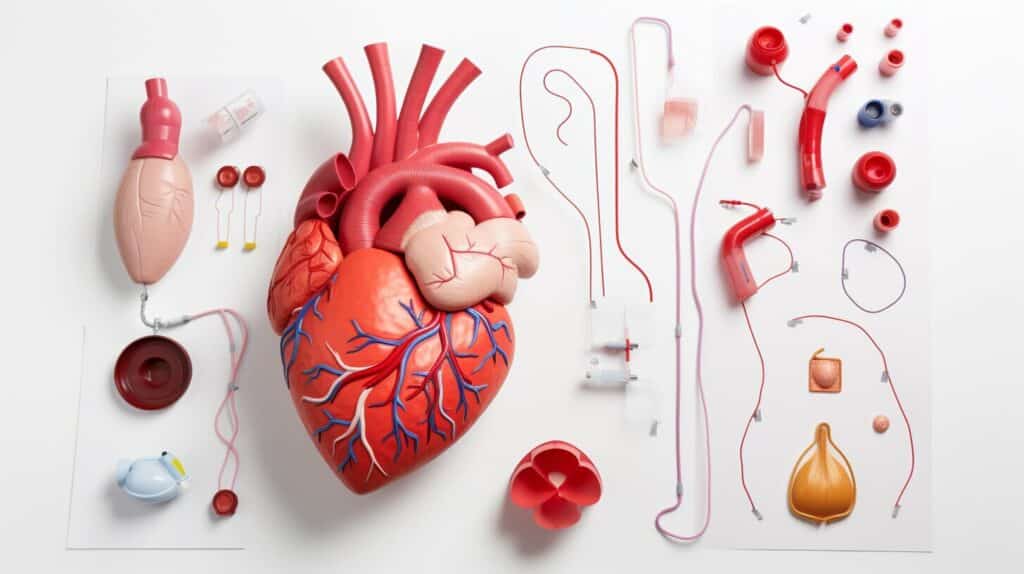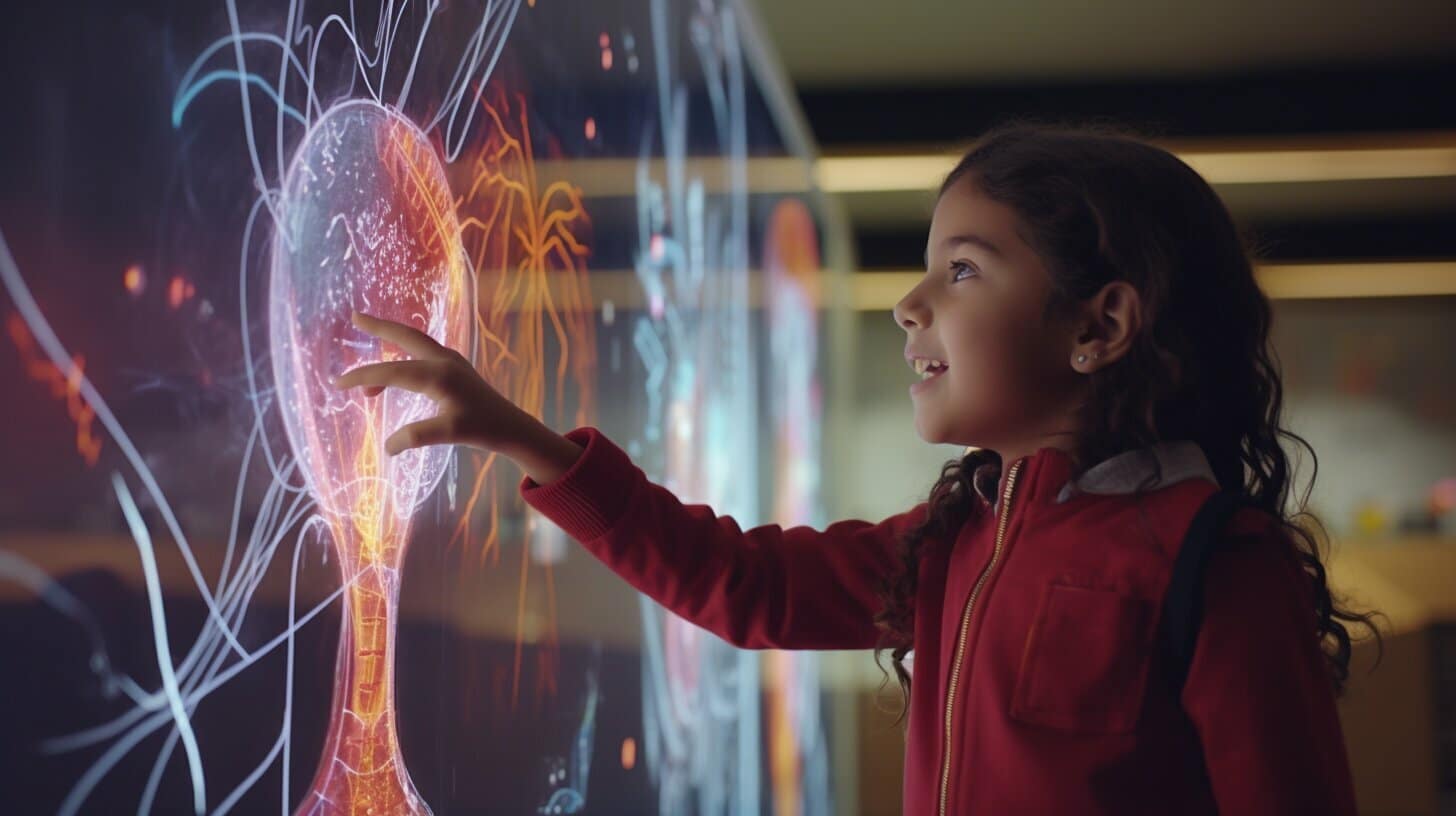Explaining complex bodily functions like the circulatory system to a child can be a daunting task, but it doesn’t have to be! Understanding how the heart pumps blood throughout the body is essential for children’s health and wellbeing. In this section, we will provide you with tips and tricks to make the learning process fun and easy for your child.
Key Takeaways:
- Explaining the circulatory system to a child can be simplified with age-appropriate language and engaging activities.
- Storytelling, visual aids, and hands-on props can make learning about the circulatory system more fun and interactive.
- Games, videos, and fun facts can help children retain information about the circulatory system.
- Additional learning resources like books, apps, and websites can be used to supplement a child’s understanding of the circulatory system.
What is the Circulatory System?
Before explaining the circulatory system to your child, it’s important to understand what it is yourself. The circulatory system is a complex network of organs and vessels that work together to transport blood, nutrients, and oxygen throughout the body. The main components of the circulatory system are the heart, blood vessels, and blood.
The heart is a muscular organ that pumps blood throughout the body. It has four chambers: the left and right atria, and the left and right ventricles. The atria receive blood from the body and lungs, while the ventricles pump blood out to the body and lungs.
The blood vessels include arteries, veins, and capillaries. Arteries carry oxygenated blood away from the heart to the rest of the body, while veins carry deoxygenated blood back to the heart. Capillaries are the smallest blood vessels and they connect arteries and veins, allowing for the exchange of nutrients and waste products.
The blood itself is made up of red blood cells, white blood cells, plasma, and platelets. Red blood cells carry oxygen throughout the body, while white blood cells help fight off infections. Plasma is a yellowish liquid that carries nutrients, hormones, and other substances throughout the body. Platelets help with blood clotting, which is important for healing wounds.

Understanding the basics of the circulatory system will help you explain it to your child in a way that they can understand.
Engaging Activities to Learn about the Circulatory System
Learning about the circulatory system can be fun and engaging with the following activities:
Circulatory System Board Game
Create a board game where players must navigate the circulatory system and learn about its components along the way. Use a large sheet of paper to draw the board, include illustrations of blood vessels and organs, and add trivia cards with questions related to the circulatory system. Make sure to use fun and colorful game pieces to keep the players engaged!
Heartbeat Music
Use a stethoscope to listen to your heartbeat and have your child try to match the rhythm with different musical instruments or sounds. This can be a fun way to teach children about the important role of the heart in the circulatory system.
| Recommended Age: |
4+ |
| Materials Needed: |
Stethoscope, musical instruments or sounds (drum, clapping, etc.) |

Blood Cell Art
Get creative with arts and crafts by making blood cell art. Use different colored pom-poms, pipe cleaners, and construction paper to create different types of blood cells. Have your child label and explain the function of each cell.
| Recommended Age: |
6+ |
| Materials Needed: |
Pom-poms, pipe cleaners, construction paper, glue, markers |
Balloon Blood Flow
Using balloons to represent the heart and blood vessels, demonstrate how blood flows through the circulatory system. Inflate a large balloon to represent the heart, and smaller balloons for the blood vessels. Have your child push the inflated balloons to demonstrate how blood flows through the veins and arteries.
| Recommended Age: |
3+ |
| Materials Needed: |
Balloons, string |
By making learning fun and interactive, children can develop a solid understanding of the circulatory system. Try out these activities and discover new ways to make learning about the human body exciting!
Storytelling and Visualization
Children love stories! Storytelling and visualization techniques can be a great way to explain complex concepts like the circulatory system to children. Creating a narrative or visual representation of how blood travels through the body can help children understand the process better.
To create an engaging story, you can start by introducing the main components of the circulatory system, such as the heart and blood vessels. You can then talk about how the heart pumps blood through the body, delivering oxygen and nutrients to different organs and tissues. Use colorful language and vivid imagery to bring the story to life.
Visualization can also be a powerful tool. You can use drawings or diagrams to show how blood flows through the body. For example, you can draw a picture of the heart with arrows pointing to different parts of the body, such as the lungs and brain, to show how blood travels to different organs.

Another fun visualization activity is to create a “blood flow” obstacle course. Set up different stations around the room, each representing a different organ, and have children “deliver” oxygen and nutrients to each organ by running and jumping through the different stations.
By using storytelling and visualization techniques, you can make learning about the circulatory system fun and engaging for children.
Using Props and Models
Using props and models can be a great way to help your child visualize the circulatory system. One simple DIY model you can make at home is to use straws to represent blood vessels and food coloring to represent blood. Use a large straw for the heart and smaller straws for the veins and arteries. Connect them together using tape or glue and have your child pour the colored water through the straws to simulate blood flow.
Another fun option is to use play dough to create the different parts of the circulatory system. Mold the heart, veins, and arteries, and have your child put the pieces together to create a full system. This can be a great hands-on activity that engages your child’s creativity and helps them learn through tactile exploration.

You can also use pre-made models or diagrams to help your child understand the circulatory system. Look for interactive models that allow your child to manipulate the different parts and see how they function together. You can also find free downloadable diagrams and worksheets online that your child can color and label for added learning.
Teaching Through Games and Videos
If your child is a visual learner, games and videos can be a fun and engaging way to teach them about the circulatory system. Many online resources offer interactive lessons and educational games that can keep children entertained while they learn.
One great resource is the game “Body Parts” by Osmo, which uses augmented reality to teach children about various body systems, including the circulatory system. Your child can manipulate virtual organs and see how blood flows through the body.
Another fun resource is the video “The Circulatory Song” by Scratch Garden. This catchy tune teaches children about the parts of the circulatory system and their functions. Your child can sing along and learn valuable information while having fun.

For more educational games and videos, you can check out resources like PBS Kids and BrainPOP Jr. These websites offer a variety of age-appropriate educational content on a range of topics, including the circulatory system.
Fun Facts about the Circulatory System
Learning about the circulatory system can be fun, especially when you discover these interesting facts:
- The heart beats around 100,000 times a day!
- The smallest blood vessels in your body are called capillaries and they are only one cell thick!
- Your body has around 5.6 liters of blood
- The blue color of your veins is not actually due to “blue blood,” but because of the way your skin absorbs and reflects different colors of light.
- The aorta, the largest artery in the body, is almost the diameter of a garden hose!
- Red blood cells are created in your bone marrow and they have a lifespan of around 120 days!
These are just a few of the many fun facts about the circulatory system. Encourage your child to keep learning about the body and all its amazing functions!

Answering Common Questions
As you explain the circulatory system to your child, you may encounter some common questions. Don’t worry if you don’t know the answers yourself – we’ve got you covered! Here are some of the most frequently asked questions and their simple answers:
What is blood?
Blood is a liquid that flows through our bodies. It is made up of red blood cells, white blood cells, and plasma. Red blood cells carry oxygen to our body’s organs and tissues, while white blood cells help fight infections. Plasma is a yellowish liquid that carries nutrients, hormones, and waste products throughout the body.
What are veins and arteries?
Veins and arteries are types of blood vessels. Veins carry blood from the body back to the heart, while arteries carry blood away from the heart to the body’s organs and tissues.
Why is the heart important?
The heart is an essential part of the circulatory system. It pumps blood to the body’s organs and tissues, delivering oxygen and nutrients that are needed for growth and energy. Without the heart, the circulatory system would not function properly.
How does exercise affect the circulatory system?
Exercise can benefit the circulatory system in several ways. It increases heart rate and blood flow, which can strengthen the heart and improve blood vessel function. Regular exercise can also help reduce the risk of heart disease and other circulatory problems.

Explaining the circulatory system to a child can seem intimidating, but with the right approach, it can be a fun and engaging learning experience. By using storytelling, visual aids, and interactive activities, you can help your child develop a solid understanding of this vital body system. Answering common questions along the way can also help strengthen their understanding and curiosity. Keep these tips in mind as you teach your child about the circulatory system, and remember to make it fun!
Learning Resources for Further Exploration
If you want to delve deeper into the circulatory system with your child, there are many resources available to help you. Here are a few suggestions:
- The Magic School Bus Inside the Human Body by Joanna Cole and Bruce Degen: This classic children’s book takes readers on a wild ride through the human body, including the circulatory system. It’s a fun and informative way to introduce children to the wonders of the human body.
- Kids Health: This website provides a wealth of information on the circulatory system and other aspects of the human body, with articles, videos, and interactive games. It’s a great resource for children and parents alike.
- Human Anatomy Atlas app: This app allows children to explore the human body in 3D, including the circulatory system. It’s a great tool for visual learners and can make learning about the circulatory system more interactive and engaging.
By using these resources, you can help your child develop a deeper understanding of the circulatory system and the body as a whole. It’s never too early to start learning about the amazing machine that keeps us all alive and healthy!

Conclusion
Congratulations! You have learned how to explain the circulatory system to a child with fun and easy tips. Remember to keep the learning process engaging and interactive, using techniques such as storytelling, visualization, and hands-on activities. Encourage your child to ask questions and foster their natural curiosity about their body.
Using props, models, educational games, and videos can also go a long way in helping your child understand this complex bodily function. Don’t forget to share fun facts about the circulatory system to make learning exciting and memorable.
If you want to continue exploring the circulatory system with your child, we recommend checking out our suggested learning resources such as books, websites, and apps. These resources can help your child deepen their understanding and satisfy their thirst for knowledge.
Remember, explaining the circulatory system to a child can be a challenging task, but with the right tools and techniques, it can be an enjoyable and rewarding experience. Keep up the good work and have fun learning!
Can the Fun and Easy Techniques Used to Explain the Circulatory System Also be Applied to Explain Weather to a Child?
Fun techniques for explaining weather to a child can indeed be applied, similarly to the way the circulatory system is explained. Just as using engaging visuals and hands-on activities reveal the complexities of the human body, utilizing interactive experiments, colorful diagrams, and relatable examples can make learning about weather enjoyable and understandable for young minds.
FAQ
Q: How can I explain the circulatory system to a child in a fun and easy way?
A: Explaining the circulatory system to a child can be made fun and easy by using engaging activities, storytelling, props and models, games and videos, and fun facts. By incorporating these techniques, you can make learning about the circulatory system an enjoyable experience for children.
Q: What is the circulatory system?
A: The circulatory system is a vital part of the human body that transports blood, oxygen, nutrients, and other substances throughout the body. It consists of the heart, blood vessels, and blood. The heart acts as a pump to circulate blood, while the blood vessels serve as pathways to carry blood to different parts of the body.
Q: What are some engaging activities to learn about the circulatory system?
A: Engaging activities to learn about the circulatory system include creating artwork of the circulatory system, playing educational games, doing experiments with water and straws to simulate blood flow, and conducting simple pulse rate experiments. These activities help children visualize and understand how the circulatory system works.
Q: How can storytelling and visualization be used to explain the circulatory system?
A: Storytelling and visualization can be powerful tools in explaining the circulatory system to children. By creating engaging stories that involve the circulatory system and using visual aids, such as diagrams or illustrations, children can better grasp the concepts and make learning more enjoyable.
Q: How can props and models be used to demonstrate the circulatory system?
A: Props and models can be used to demonstrate how the circulatory system works. For example, using a balloon and straws to represent the heart and blood vessels can help children visualize the flow of blood. DIY models, such as a water bottle heart model or a playdough blood vessel model, can also be used to enhance understanding.
Q: Are there any educational games and videos available to teach kids about the circulatory system?
A: Yes, there are various educational games and videos available that can teach children about the circulatory system. Interactive games or apps that allow children to explore the circulatory system or watch animated videos that explain its functions can make learning more interactive and engaging.
Q: What are some fun facts about the circulatory system?
A: Here are some fun facts about the circulatory system: The heart beats around 100,000 times a day, blood vessels in the body can stretch over 60,000 miles if laid end to end, and blood cells are produced in the bone marrow. These facts can make learning about the circulatory system more exciting and memorable.
Q: What are some common questions children might have about the circulatory system?
A: Common questions children might have about the circulatory system include: How does blood travel through the body? Why does the heart beat? How does the circulatory system help the body? By providing simple and concise answers to these questions, children can develop a better understanding of the circulatory system.
Q: Are there any learning resources available for further exploration of the circulatory system?
A: Yes, there are various learning resources available for further exploration of the circulatory system. Books, websites, and apps specifically designed for teaching kids about the circulatory system can provide additional information and activities to deepen their understanding.
 Understanding the basics of the circulatory system will help you explain it to your child in a way that they can understand.
Understanding the basics of the circulatory system will help you explain it to your child in a way that they can understand.

 Another fun visualization activity is to create a “blood flow” obstacle course. Set up different stations around the room, each representing a different organ, and have children “deliver” oxygen and nutrients to each organ by running and jumping through the different stations.
By using storytelling and visualization techniques, you can make learning about the circulatory system fun and engaging for children.
Another fun visualization activity is to create a “blood flow” obstacle course. Set up different stations around the room, each representing a different organ, and have children “deliver” oxygen and nutrients to each organ by running and jumping through the different stations.
By using storytelling and visualization techniques, you can make learning about the circulatory system fun and engaging for children.
 You can also use pre-made models or diagrams to help your child understand the circulatory system. Look for interactive models that allow your child to manipulate the different parts and see how they function together. You can also find free downloadable diagrams and worksheets online that your child can color and label for added learning.
You can also use pre-made models or diagrams to help your child understand the circulatory system. Look for interactive models that allow your child to manipulate the different parts and see how they function together. You can also find free downloadable diagrams and worksheets online that your child can color and label for added learning.
 For more educational games and videos, you can check out resources like PBS Kids and BrainPOP Jr. These websites offer a variety of age-appropriate educational content on a range of topics, including the circulatory system.
For more educational games and videos, you can check out resources like PBS Kids and BrainPOP Jr. These websites offer a variety of age-appropriate educational content on a range of topics, including the circulatory system.

 Explaining the circulatory system to a child can seem intimidating, but with the right approach, it can be a fun and engaging learning experience. By using storytelling, visual aids, and interactive activities, you can help your child develop a solid understanding of this vital body system. Answering common questions along the way can also help strengthen their understanding and curiosity. Keep these tips in mind as you teach your child about the circulatory system, and remember to make it fun!
Explaining the circulatory system to a child can seem intimidating, but with the right approach, it can be a fun and engaging learning experience. By using storytelling, visual aids, and interactive activities, you can help your child develop a solid understanding of this vital body system. Answering common questions along the way can also help strengthen their understanding and curiosity. Keep these tips in mind as you teach your child about the circulatory system, and remember to make it fun!







